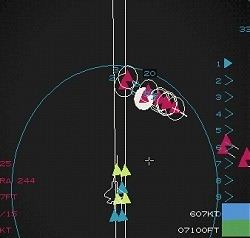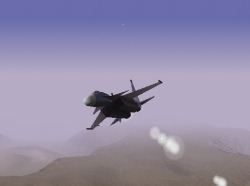| TOTAL AIR WAR - A Commentary by Gavin Bennet |
||||
|
DID tried to surmount these obstacles by setting their game in a future where other nations have had a chance to catch up; such aircraft as the Su-37, the MiG-35, the Rafale and the EF2000 Typhoon have been mass produced and sold to potential enemies. This seems a particularly ham fisted attempt to enforce that game balance. Combined with the seemingly endless supply of enemy front-line fighters, this renders a lot of playing the game rather…. Pointless. Why bother risking your aircraft (and sanity) taking on 100 planes a night. They are still going to keep coming. In EF2000 I often risked my plane and the outcome of the war to strafe enemy planes on the ground. I only discovered recently how pointless this was. The runways, not the planes, were the key. Not knowing the precedent, I tried this in TAW also. Sometimes, I could kill 12 or so planes and resume my CAP unharmed. A clever and decisive sneak attack you might think? Well, not really. You do not see any reduction in enemy air presence in that sector. In fact, as I have mentioned earlier, maul a few dozen enemy strike missions over a 24 hour period in real life, you will start seeing changes at the very least., or more likely a cease-fire. II Future Air Wars. In theory and practise. In 2005, shortly after the first USAF F-22 Squadrons became active, the first exports were made to America's traditional ally, Israel. The F-22s were assigned to a new squadron with an old name, the Spitfire Squadron, and were now based in the Negev desert. The squadron was renamed the First Raptor Squadron, but retains its old squadron patch. In 2007, the Egyptian military seizes power in Egypt. The Egyptian military seized power during a long period of national uncertainty, including Egyptian fears of the increasing power of its neighbour, Libya, and the conflict between the younger, liberal secularists and the older, more hardline Islamists. The military seized power and then attempted to gather support of the Islamists. The Islamists then tried to steer the new government's policy to an anti-Israel, anti-western stance. In response, Israel deploys more troops to the border with Israel, and them starts supporting anti-government operations in Egypt. Following Egypt's occupation of Sudan and Russia's control of Ethiopia, NATO troops are deployed to Saudi Arabia, and, reluctantly, Israeli squadrons are invited to join the coalition attempting to bring the crisis to a peaceable conclusion. Rebel, Israeli supported troops occupy most of the region between Suez and the Israeli border, and Israel has threatened to invade if Egypt moves east. In the Second World War, Germany went through possession of over 10,000 aeroplanes. It lost in the region of five hundred in the bloody month of August 1940. No one can sustain that sort of loss anymore, even proportionally. Nowadays, fighter aircraft cost what an aircraft carrier once cost. (In the Second World War, Canada had an aircraft carrier. Nowadays, its CF-18 fleet strains its military resources. Ireland (pause as the author coughs guiltily) had a squadron of top of the range fighters - Hurricanes. Ireland hasn't actually progressed much further in terms of airpower…. ;-). Australia had a fairly large airforce, and New Zealand had a carrier (I think). One of the cheapest modern fighters, the F-16A will set you back seven million sterling. Britain's Department of Defence budget for 1999-2000 is 21 Billion, Sterling ($33.6 Billion US). In 1996, the US spent $255.3 Billion, France, $38.4 Billion, UK $32 Billion, Canada $7.7 Billion. The West has three nations which can still, honestly, claim super power and international intervention ability, USA, France, Great Britain. This is determined by the fact that these nations have Carrier fleets, support structures and self-sustainable deployment capability. Keep this in mind as we continue. "You need three things to win a war; money, money and money" - Tivulzio (1441 - 1518) Never a truer word spoken. The backbone of the RAF fleet is the mighty Tornado Fighter Bomber, and it costs 35 Million Sterling ($56 Million US) apiece. The RAF has less then 500 active military aircraft. This includes training aircraft, support aircraft and the warplanes themselves (Tornado Gr.1, Gr.1b, Gr.4; Tornado F.3 and Harrier Gr.7) which are only a minority. Britain lost 6 Tornado fighter-bombers in the Gulf conflict. In those last Cold War days, pre-drawdown, this was seen as terribly, terribly high. If the RAF lost 6 Tornados in Bosnia, or on Operation Northern Watch, or Southern Watch, or over Kosovo today, the consequences would be disastrous. With this in mind, consider, in Total Air War, in the course of an hour, the enemy, Sudan, lost 12 Su-27 Flanker fighter-bombers (cost, roughly $35 Million US).
I shot down (in Operation Outcast) at least 20 Rafales in the same period. And (in Outcast), a similar number of Su-27s, and twice that number of MiG-27 and Su-25s. Losing 32 planes in such a period, in a modern conflict, especially 32 front-line fighters, top of the range warplanes, would have distressed IA-PVO generals in the event of World War 3, in the bad old days. And the enemy lost that number to me… one lousy flight of F-22s. I would not at all be surprised if the final tally of lost enemy aircraft in that one hour in Outcast was well over a hundred. In the real world, losing any significant amount of aircraft does not merely imply that you are now X-amount of aircraft down, with only Y-amount left. It goes deeper than that. There is a ruthless mathematics at work here. Every plane needs maintenance, and their pilots need rest. If an enemy is taking a toll on your CAP force, then the amount of aircraft available for your CAP is reduced, but not the requirement for the CAP, meaning that the downtime required for aircraft maintenance is reduced. This means that the available aircraft is reduced even further, or the time between maintenance is reduced, meaning that your own air cover is lessened. If the worst happens, and an enemy plane takes out a squadron on the ground, then things get FAR worse. |
Warplanes are severely limited in range. So, if, for example, your Squadron of Su-27s is strafed on the tarmac at Bodo, incurring 60 percent losses, not only have you lost most of your aircraft, but also the base is disrupted. Until you have dragged the burning wrecks from their revetments (7 or eight burning aircraft, with highly flammable aviation fuel everywhere? - give it a minimum of six hours.), that base is probably, for all practical purposes, inoperable. And that is before the headaches of resupplying the base.
This means that your CAP force at the nearest friendly airbase will have to increase its range until the base is fully capable again. Until that happens, your airforce, in that sector is a: losing downtime, b: operating at greater range, and thus has less fuel for manoeuvre and dogfight; c: using more resources (i.e., the war is becoming more expensive). A proportion of your aircraft will need more maintenance, and, because of the wider CAP requirement for the operable squadrons, they will have to trade off either weapons load or time aloft. So, now, over a large front, you are now that bit more stretched. Okay, it is a limited, critical time, you can deploy reserves, or repair what can be repaired and get up to strength, but in that time you have an enemy who can strike more freely at your HVAs, or engage your weakened CAP and get closer to air superiority. It means that enemy ships can operate closer to your littoral regions, and have less fear of anti-ship strike aircraft. When you go out to engage these fleets, you cannot be sparing fighters for escorts. Thus, without even bombing the runway it is possible to really hobble your opponent, and make his life difficult by simply strafing a dozen aircraft on the ground. Remember, that was Adolf Galland's main tactic in the Battle of Britain, to beat the RAF on the ground, and it was only because of an accident (bombing London) that this was interrupted. The RAF was within days of total defeat as a result. Once the enemy stopped engaging the RAF Southern Airfields, the "few" were able to wreak havoc. War is economic in nature. It is, to quote Tom Clancy, "armed robbery writ large." Wars are expensive, perilously so. World War II bankrupted Britain and ended its empire. (actually, the US made money from it, through the War Bonds - clever people!)
If 32 expensive front-line fighters are lost in one day, never mind an hour, then that nation is in financial trouble, akin to the government exchequer losing over a Billion from its economy - a Billion that could fund tax cuts, hospitals, schools, and other things. The TAW scenario holds that someone finds a great deal of oil and the Red Sea littoral nations (who in real life hate one another with a vengeance, and are gearing up militarily) become rich and militarily powerful. Actually Oil is not the big deal nowadays as it was - you need more than oil to make your nation rich. Nigeria, Sudan, and Russia have huge reserves of the stuff, and none of them are particularly rich. You need economics to turn that oil into money. I prefer to consider the nations of TAW to be Lion Economies (after Francois Heisbourg's wonderful book little booklet, the "Future of Warfare", which had some wonderful scenarios to demonstrate his theories.) The TAW scenarios would cause so much mayhem to the economic infrastructure of these little Lion economies, the results would be felt world wide. Imagine, if you will, the consequences of Singapore going to war with Malaysia. Also, remember, that just because Britain held out so long against the Luftwaffe, does not mean that Ethiopia would be able to hold out against a dedicated NATO bombing campaign, no matter how advanced their airforce is. How long before a meeting of the country's Central Bank and the Prime Minister, with the central bank warning that unless the war ends, the nations GDP will fall, and foreign investment will dry up? Yes, TAW models this to an extent, with required percentages of Industrial or political or whatever targets. But why must there be a fixed percentage? Today, there are many sundry reasons that end wars. Wars are never purely military occurrences anyway. They are factors of politics and economics. In TAW's future, Television and the Internet will be prevalent even in the wilderness of Eritrea. Wars are never pleasant and the media will see these things as the media sees fit, and that will determine what the politicians are hearing from the people. Also, neutral nations, as well as entering the war on one side or the other may well put pressure on the warring factions to desist. After all, they do not want their economies and their markets put in jeopardy by a spat between their neighbours. EF2000 had a macro war; TAW does also, but EF2000, everything happened off-stage, and you could assume things were happening. Eight hours pass and Sweden in on your side. That is a little easier to swallow than the TAW variant. The game pauses for a second, a message appears, Egypt has joined the enemy side. WTF? (curses, snarls, bah humbug, drools). And thus it is, in the space of a game hour, your enemy has doubled in size, and now has F-22s. Even more trying. Even more tempting to give up. Go to part III
|
|||
|
© 1997 - 2000 COMBATSIM.COM, INC. All Rights Reserved. Last Updated February 1st, 1999 |
||||




